
The federal government wants to double the number of international students like Githin Mathew, a postgraduate student in International Business Management at George Brown College, over eight years. File Photo: Danilo Barba/The Dialog
Jane Lytvynenko
Canadian University Press
OTTAWA (CUP) — Canadian university classrooms could have twice the number of international students in the next eight years. On Jan. 15, the Conservatives announced a strategy to double the amount of researchers and students coming from abroad. The program centers around $5 million per year in funding primarily going toward branding and marketing. The funding was approved as a part of the Economic Action Plan last year.
Minister of International Trade Ed Fast announced the program at Ryerson University. Fast said in a press release that in addition to the marketing money, “the strategy will provide $13 million over two years to the Globalink program of Mitacs, a national not-for-profit organization that fosters innovation through research and training programs.”
The initiative will focus on six key regions: Brazil, China, India, Mexico, North Africa and the Middle East and Vietnam.
While critics say an increase in international students is a positive overall goal, they add there needs to be more details on the program. Alex Usher, president of Higher Education Strategy Associates, says the newly announced strategy needs to be better thought out to be successful.
“There are lots of reasons why you might want to increase the number of international students but lets be explicit about what they are and work backwards from there,” says Usher, adding there is no clear purpose for doubling international students.
Usher says the document presented by Fast should not be called a strategy. He wondered whether provinces and educational institutions were consulted when putting together the plan.
“The only goal I can see is double the number of incoming students,” he says. “I don’t know why that number was picked and if you don’t know why the number was picked you’ll have a hard time justifying it.”
Dan Harris, the NDP post-secondary education critic, said the idea of doubling international students in Canada is not a bad one.
“They [international students] make an important part of the student body in Canada and help provide resources to universities through tuition fees,” said Harris.
He added the government needs to ensure the resources and support are there for the new international students, many of whom face a culture shock when coming to Canada. Gary Slater, associate vice-president international at the University of Ottawa, says new students often have a language barrier and have to deal with different methods of teaching from what they’re used to.
Harris echoed Slater’s concern with resources for international students, saying, “We have to make sure they succeed and we have no problems arise from a larger student body.” He added that universities will need additional funds to provide adequate programming for the new students, something that’s not currently outlined in the strategy.
Slater said that because education is a provincial matter, the federal government can only hope the numbers double as projected. The rest of the work falls on the provinces, some of which have a hard time recruiting international students.
“We have to recognize that a national policy like that will be differently seen in the French and the English world,” said Slater, pointing out that Quebec has a harder time recruiting international students. “It’s much easier to recruit students that want to study in English than in French. We have to work hard if we want to keep a linguistic balance in the country.”
Slater said while Canada has a great post-secondary education system, it has to compete with the USA. That’s where the $5-million yearly initiative for advertising comes in.
“The number one thing the federal government can do is give Canada a good reputation outside the country,” said Slater. “It’s a marketing issue to a large extent.”
According to Harris, Canada also needs to ensure there is an easy way to immigrate for international students who decide to stay. “We should be putting a focus on making sure there is a path to immigration and family reunification,” he says.
Whether the students stay or go back, Slater said anyone studying in Canada is an asset for the country. Those moving back often forge strong links with the institution they studied in, while students who immigrate contribute to the economy.
“They bring a lot not only to university but to society,” said Slater.


